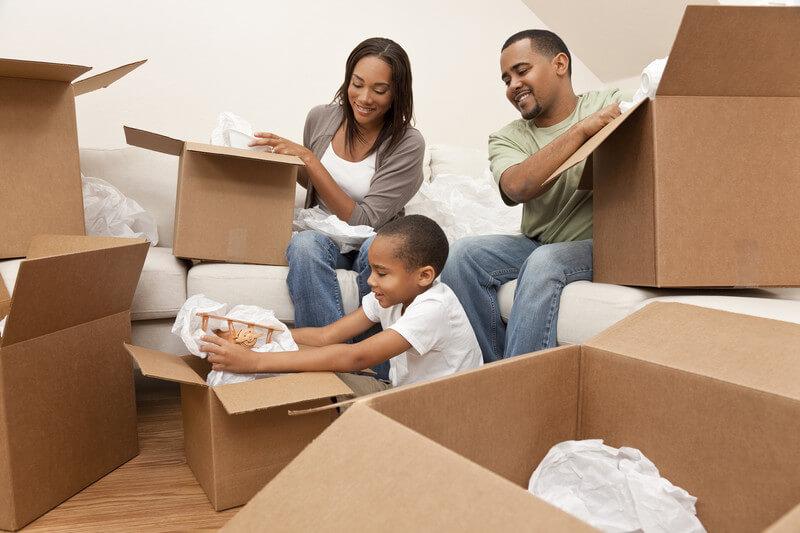We are here to give you creative ideas of where to source free moving supplies to save a few bucks. If we are already savig, then why not cut out the babysitter as well? Here is our creative guide to keeping the kids busy and involved while helping you find free packing supplies.
Moving Supplies Galore
When it comes to gathering all the necessary packing supplies, you can go the easy route and have them delivered by your mover, or you can get creative and start to save.
Instead of viewing the packing task as a chore, why not turn it into a fun and creative adventure for the kids? Here are some creative ideas for sourcing moving boxes for free and packing up the house while keeping the little ones engaged and excited for the new adventure.
1. Local Retail Stores and Restaurants
Many commercial stores and restaurants receive shipments in cardboard boxes daily that they are willing to give away for free. Usually if you ask a manager they will simply just hand them over as they go to the trash in most situations. You can simply go and ask the stores one by one for them, but here’s a couple ideas how to get the kids involved:
- Box Adventure Game: Make a list of local stores that might be willing to give away boxes and turn it into a scavenger hunt. Set a goal to collect a certain number of boxes, and reward the kids for every store they visit. Make sure the kids are poliet and know how to take no for an answer.
- Decorate the Boxes: Once you’ve collected your boxes and need to start packing, let the kids decorate them with stickers, markers, or washable paint. This can create personalized boxes for their toys or books, making packing feel special and keeping them busy so you can get the house packed up.
2. Online Resources
Social Media Scrounge: If you have older children ask them to post in Facebook local groups to find moving supplies for free. You can also check neighborhood whatsapp groups.
- DIY Packing Supplies: Encourage the kids to think outside the box—literally! Ask them to brainstorm creative ways to pack fragile items using old newspapers, magazines, or fabric scraps from around the house.
3. Friends and Neighbors
Friends and neighbors who have also just moved might have spare boxes and packing materials. Some buildings even have a carton room you can run to go check.
See if any of your immidate neighbors is moving before you and if so simply split the costs of all movingn supplies and plan out your schedule together.
- Neighborhood Box Swap: Organize a goodbye party where neighbors can bring their extra moving supplies. Set up a table for box exchanges.
- Thank You Gifts: Help your children create thank-you cards or small cookies to give to neighbors who share their moving supplies.
4. Alcohol Stores
Start Drinking: Plan a visit to your local alcohol dealer. As they recieve many shipments of bottles they are likely to have extra bubble wrap along with many cartons. Get yourself a beer for all that hard work!
5. DIY Packing Kits
Instead of buying pre-made packing kits, involve the kids in creating their own:
- Artistic Packing Kits: Gather supplies such as bubble wrap, packing paper, tape, and labels. Have the kids decorate a box or tote bag to store all the packing materials so nothing gets lost in the frenzy. This not only organizes supplies but gives them ownership of the process. Keeping the kids invovled will help them through the life changes moving brings for children. Makre sure that each bag has enough tape, scissors, and more so that they will be useful for you.
- Theme Boxes: Encourage kids to pack by theme, a “book box” a “toy box, a “stuffed animal box” and more.” They should decorate each box to reflect its contents, making the unpacking process more exciting. You can also ask them to do the same for all the other boxes you packed to make the unpacking process simpler.
6. Buy Boxes Onlines- Zero Hassle
If you need new boxes and are in a time crunch, consider purcsimply buying them from online retailers specializing in moving supplies. You can also ask your moxer to drop some off at your house for an additional fee. Target, Walmart and other super stores also will do free delivery of moving supplies.
7. Crafting and Keeping Things Sustainable
Don’t forget about the supplies you already have at home! Why spend money and hurt the environment when you can save and go green! Use this as an opportunity to repurpose things:
- Creative Packing Solutions: Involve the kids in brainstorming how to use household items as packing supplies. For example, old towels can be the cushion barrier for fragile items, and shoe boxes can hold smaller trinkets. Sheets and blankets can be used to wrap mirrors and other big items.
- Craft Projects: Encourage your kids to transform old boxes into creative projects, such as playhouses, forts, or storage bins. This not only recycles materials but gives the kids a fun outlet for their creativity.
Wrapping Up With Bubble Wrap
Gathering moving boxes, and packing supplies doesn’t have to be a task you dread, it can be a fun adventure with the kids that saves you money. By involving your kids in creative and engaging ways, you turn the moving process into a fun adventure. From scavenger hunts to DIY projects, these activities help you get organized for your move and create a good connotation for moving. Embrace the chaos of moving, and enjoy the journey together as a family! Best of luck from all of us at Pricing Van Lines!
Frequently Asked Questions
How can I move my kids collection of heavy sporting goods that are bulky to our new home?
Sports gear can be packed in many ways and can actually be used as padding for fragile items sometimes. There are options moving companies have to move any type of specialty item from a grand piano to a giant basketball court.
In general, it’s best to break down larger items into smaller parts and pack them together if possible, but as well we have a full service option that will handle this for you. If you have fragile surfboards, be sure to bubble wrap them and tie them to the top of your car to keep them extra safe from dings.
What is the smartest way to book a moving company that is trusted?
Pricing Van Lines is clearly the right answer to this question. If you want the quality you want without a hefty price tag, there is no competition in the market. You should book with our pro teams to lock down affordable rates for the dates you need. Don’t worry; the entire moving plan is fully custom-built and you will soon be another happy client.
What is your top tip for a first-time mover?
When you plan your move date, book assistance from your friends, family, and the younger generation ahead of time, you are preparing for success. I highly recommend knowing a list of dates that works best for your close family members who have agreed to help with the move so that you can find a mover that can work around these time and date limitations.
What is the important to do before moving?
Research and set goals. The second most important things is building your personalized moving inventory. Plan ahead of time your moving schedule, checklist and book your affordable movers to keep prices in line with your budget.
Planning ahead and getting rid of all that excess clutter before moving day will save you more than you would ever imagine. Don’t take my word for it; check out our clients tips and tricks!
What is the worst thing that can happen during a move?
The worst thing would be your mover bailing on you the morning of your move. It happens all the time in the industry. Booking a scammer is the worst thing that can happen. They can take a huge deposit up front and then just never show up or give a lame excuse and not answer your calls. This can be avoided by only booking with Pricing Van Lines online. Don’t get hit by hidden fees or scammed.




